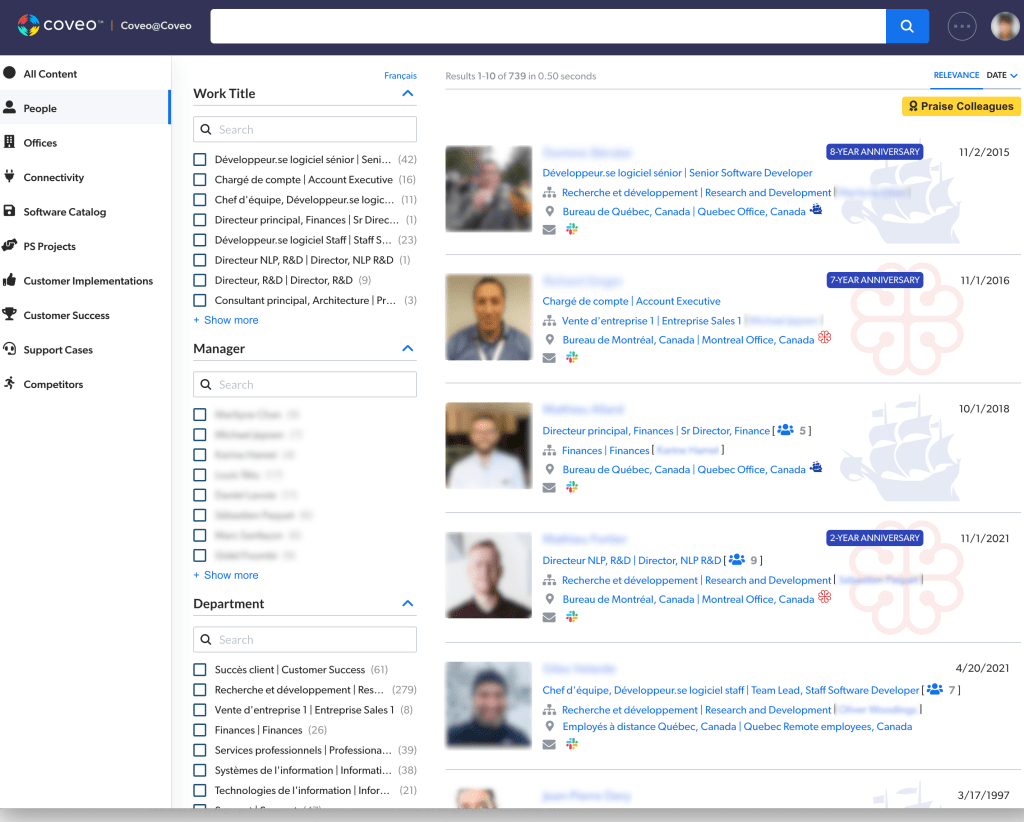One of the challenges facing CIOs is that any system being deployed — whether customer-facing or not — must create a demonstrable value.
There are endless requests for budget and resources to build applications that help employees find … HR information, documentation, support tickets, sales enablement, in-product training, etc. Or to help customers and partners understand our product and gain support.
Further, when a system is implemented, we need that technology to be adopted. That means that the desired changes in behaviors — from not knowing to knowing, from not finding to finding, from not being accountable to being so — are realized and maximized with that technology adoption.
Turns out adoption is heavily linked to user satisfaction.
This is the backdrop to how and why we developed Coveo@Coveo — or what we fondly call, Customer Zero. In essence, we built a search center of excellence (SCoE).

Here is what you, as CIO, can learn from our efforts.
Developing a Search Center of Excellence
As the maker of an AI search and generative experience platform, the first mandate was to use our platform internally. And because it is a composable platform – with a library of necessary components that stem from APIs to machine learning modules, we knew we could tackle several different challenges that we needed to solve.
Over this and the next couple of blogs, I’ll share the challenges — and provide recipes as to how we solved them, and the insights we learned. And most importantly, how it benefited us.
I aim to give you a deeper insight into what a Coveo deployment means in terms of function, technology, security, personnel, and relevance tuning.
It’s crucial to point out that while we have a dedicated Coveo@Coveo team (more about that later), the task of our internal rollout isn’t the job of one team alone. At Coveo, everyone has the power to contribute and make an impact, either through idea sharing or proposing complete solutions.
Our Coveo@Coveo team effectively handles the requests they receive from the business (marketing, sales, services…) as well as the maintenance of the application. They also collaborate with R&D to deploy new Coveo features. But their main role is to steer collaboration among all Coveans.
One Application — Multiple Audiences and Use Cases
An undertaking of this nature was important because of the sheer number of applications we had been managing. We wanted to reduce it to one — that still served a variety of audiences, each with their own needs — with information ensconced in different data sources.
They included:
| Audience | Customers | Partners | Employees |
| Solution | Service & Support Website | Service & Support Website | Workplace |
| Main Use Cases | ⦁ Website Search ⦁ Community Search ⦁ Documentation Search ⦁ Training Search ⦁ In-Product Experience ⦁ Customer Service | ⦁ Website Search ⦁ Community Search ⦁ Documentation Search ⦁ Training Search ⦁ In-Product Experience ⦁ Business Development ⦁ Co-selling ⦁ Service Delivery | ⦁ HR Portal Search ⦁ IT Portal Search ⦁ Employee Search ⦁ Office Search ⦁ In-Product Experience ⦁ Knowledge Management ⦁ Collaboration |
| Key Integrations | ⦁ Salesforce ⦁ Sitecore ⦁ Slack ⦁ Atlassian Confluence & Jira ⦁ ServiceNow ⦁ AWS ⦁ Azure ⦁ Google Cloud ⦁ Office 365 ⦁ SharePoint Online ⦁ GitHub ⦁ YouTube | ||
| Key Features | ⦁ Automatic Relevance Tuning ⦁ Generative Answering ⦁ Smart Snippets ⦁ Faceted Search ⦁ Query Suggestions ⦁ Product and Content Recommendations – Session Based – Intent Aware ⦁ Dynamic Navigation Experience ⦁ Case Assist | ||
| Unified Platform | Coveo Platform™ | ||
The goal was an ambitious one, as we were bringing existing systems and applications onto the Coveo platform. Our belief was that the new platform would improve both performance and experiences.
Stress Testing the Platform
We might be Customer Zero, but we did have high-tech industry clients (Dell, Salesforce, VMware, Xero, for example) who we worked with to best understand how the Coveo platform can improve the customer and partner experience.
And in industries like insurance and finance, such as at Manulife, where knowledgeable employees are crucial, we had great use cases to improve access to information through Coveo.
So many more of our customers, like Caleres, Famous Footwear, and Bunnings, inspired us on how to make content on their site easily accessible with Coveo.
Over the next few posts, I’ll share our learnings, insights, and best practices on how we have created a Search Center of Excellence, with the Coveo Platform at its core. It has transformed our internal processes and empowered our entire organization, but I’m also eager to know more about what you would like to see covered in those articles. Let me know, or send me an email.
The next article will explain how we have structured our team for success. What team is needed when initially deploying Coveo and on an ongoing basis is one of the top questions I’ve received by customers over the years.
Dig Deeper
In this whitepaper, President of StarCIO Isaac Sacolick explains how you and your team can easily drive innovation across your enterprise with AI search.




